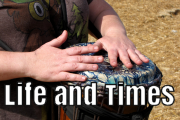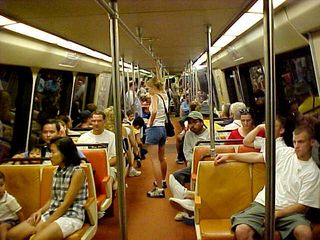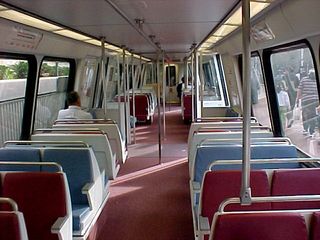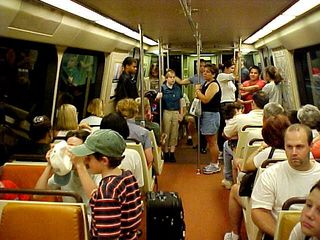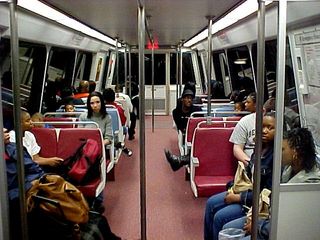If These Streets Could Talk
Part 2
One of the things that the Lincoln Memorial is best known for is being the site of Dr. Martin Luther King Jr.’s “I Have A Dream” speech on August 28, 1963. I first visited the Lincoln Memorial on July 7, 2001 when I was doing “The Schumin Web Salutes America”. However, my most memorable moment at the Lincoln Memorial was definitely the Million Worker March on October 17, 2004, where I spent most of the day out there listening to speeches, interacting with other demonstrators, and taking lots of pictures.
The Lincoln Memorial and the area around it were full of people. While not a million workers by any means (it was estimated that about 10,000 people attended), it was still a good amount there. However, it was definitely not like the stock photo that the organizers used showing the National Mall full all the way up to the Capitol.
DROOL: Determined to Remember the Opportunities, the Obstacles, and the Lessons is the title of the speech we are hearing. Meanwhile, I pan a full 360º to show what’s going on.
Near the reflecting pool, a woman conducts an interview.
People walked all along the edge of the reflecting pool as well, which at times, seemed like the only clear space to be found.
You have to admit, though – the reflecting pool, and the Washington Monument beyond it are some beautiful sights, even with the ground around the Washington Monument still torn up due to construction.
After spending the better part of an hour up in the top of the Old Post Office tower, I headed back down by way of the Congress Bells, stopping to take a quick glance at them. From there, I took a look at a small exhibit about the history of the Old Post Office building, from its construction to its abandonment as a place of postal business, to various demolition proposals to its eventual rescue and restoration to what it is today. And then, it was time to head back down to street level.
The Old Post Office’s atrium is amazing. It’s the centerpiece of the building, and the view from above is breathtaking. Everything looks so small down below. The glass elevator is visible in the upper right photo.
The people and the shops get larger as we descend in the glass elevator from the ninth floor all the way to the bottom.
Down at the bottom of the atrium, with steel arches creating the illusion of a ceiling at the third floor level, it is definitely a busy place, with lots of places to sit, eat, and shop.
Meanwhile, the glass elevator carries another load of people up to the top of the tower.
Looking up, we can see where we’d been, with the tower visible in large size through the glass roof.
Most of the shops in the Old Post Office are souvenir shops, selling stuff for the tourists, as the Old Post Office is geared primarily towards tourist traffic. And so we have all the typical stuff, like FBI shirts, politically themed signs and other clothing, etc., there for purchase by tourists.
Tourists, of course, can be identified by their awful fashion statements, such as all members of a group wearing identical clothing, often complemented by a sweatshirt or T-shirt saying “FBI” in big letters (no self-respecting DC local would be caught dead wearing one). These people can also be found bumbling like idiots in front of the farecard machines at Metro stations, standing to the left on escalators, and hanging from the overhead grab bar on the trains.
And after taking a good look at the Old Post Office, I departed, as I had other places to go on my itinerary for today. I ended up taking a walk after leaving the Old Post Office, because of its location. The Old Post Office is located right in between two Metro stations, and so it is quite accessible by train. Federal Triangle station on the Blue and Orange Lines is located right next door, while Archives-Navy Memorial on the Green and Yellow Lines is a few blocks up Pennsylvania Avenue.
And on my way to Archives-Navy Memorial station, I just have to say one thing: Fashion Police, please arrest this woman! I am of the belief that it is never acceptable to wear cowboy boots with shorts or any other article of clothing that allows a person’s bare legs to stick out above the boots.
And while crossing the street to reach the Metro, I went “In the face of danger” (which was the original name of this photo set during the early planning stages) to get you a photo of the Capitol from the center of Pennsylvania Avenue while crossing the street.
At Archives-Navy Memorial station, there was a noticeable change from past encounters with the station. The name on the station is now Archives-Navy Memorial-Penn Quarter. While the new name has been official for the better part of a year, the related signage is very new. From here, I was going to ride to Gallery Place-Chinatown via the Green Line, and then transfer to the Red Line to go to Union Station. Waiting on the platform at the station, my Green Line train came soon enough, to take me to Gallery Pl-Chinatown.
A CAF train on the Green Line, headed towards Greenbelt, arrives at the Archives-Navy Memorial station.
Since they first arrived in Washington DC back in 2001, the Green Line has always been the home of those Metro trains manufactured by CAF of Spain. The general rule is that if you want a CAF train, hit the Green Line. That was the case back in 2002 when I first rode a CAF train on April 13, 2002, and noticed all these “newfangled” colors and features that the old Rohrs and Bredas didn’t have. I even compared the old with the new, in my photo set entitled The Metro of Tomorrow.
On the old Breda trains, the carpet is orange, the walls are cream-colored, the handles on top of the seats are brown rubber, and the seats themselves are two different shades of orange. On the new Series 5000 trains, the carpet is a burgundy color, the walls are white, the handles on top of the seats are brushed metal, and the seats themselves are burgundy and blue-gray.
I still enjoy the CAF cars, though now they’re no longer the novelty that they used to be. Now, with all 192 CAF cars on the property, they’ve become commonplace in the Metro system, though, as mentioned before, most of them still live on the Green Line.
After making my transfer, I did finally arrive at Union Station. I stopped for a quick snack at Au Bon Pain inside Union Station, paying an exorbitant amount of money for a small amount of food. You see, that’s the difference between things. The name “Au Bon Pain” is expensive (I joke that it’s Au-Bon-Painful in the pocketbook to eat there), and you’re paying for the privilege of eating food that’s been associated with that name. I just went through because the line was short.
Union Station, with Au Bon Pain at left.
While I sat at a table at Au Bon Pain, which is right next to one of the main passageways in Union Station, I recalled my first visit to Union Station in February 2003. Boy, was I impressed back then…
Going further around, welcome to the shopping areas! This area is actually the area where the floor collapsed after a train accidentally crashed through a wall and into this area in 1953. Nowadays, this area is a very convenient place for tourists and commuters alike to drop their money and buy some stuff.
I still enjoy Union Station, though now it’s become another one of my designated “rest areas” in between the planned events of my DC days. Additionally, since I first did my photo set on Union Station, I’ve made better sense of how the station is laid out, and can navigate it far more effectively. In my first visit to Union Station, I had no idea that I had actually looped completely around the building and had come back to where I had started. I just followed where the building took me, and had no clue exactly where in the building I was going.
After having that quick snack at Au Bon Pain, I was once again on my way to see what I could see.
As expected, the area in front of Union Station was fairly quiet, with people passing through on their way to and from the station, to shop, eat, or catch a bus or a train.
A table was set up nearby where members of the Church of Scientology were giving free stress tests. I took one of these, and it was interesting, as they had you hold two metal cylinders, one in each hand, and watched and asked questions as the needle moved up and down on the machine that the cylinders were connected to. I don’t know how it was measuring stress, but it was interesting. The ultimate motive behind the stress test was to promote the book Dianetics by L. Ron Hubbard.
I commented to one of the people trying to pull people in for the stress test about the time that I was there in January, when the place was swarmed with demonstrators when Union Station played host to the Freedom Ball, which was one of the Inaugural Balls on inauguration day. I told the lady about how there was a big demonstration sponsored by Code Pink. The lady replied, “Well, we’re having a demonstration today.”
Somehow I think I missed something, since the lady compared an apple to an orange. While they were indeed giving free stress tests, that’s not the kind of demonstration I was thinking about. When I talk about a demonstration at Union Station, I’m talking about a big, honking protest, like at the Counter-Inaugural…
The person who seemed to be the icon of our demonstration was a small woman wearing the standard black mask, holding up a large black flag nearly as tall as she was.
This demonstration at Union Station was full of familiar faces from earlier in the day, like this woman with her “An eye for an eye will make the whole world blind” sign standing on top of a concrete barricade.
The “Abu Ghraib Fraternity” also made another appearance, with their “Torture U” sweatshirts.
Now that’s a demonstration!
Leaving Union Station, I dropped myself off right smack in the middle of downtown Washington DC, taking the Metro from Union Station to McPherson Square. It was time to take another walk near the White House…
Lafayette Park, directly across the street from the White House, has an equestrian statue of Andrew Jackson as its centerpiece.
Beyond Lafayette Park, and across a restored Pennsylvania Avenue, lies the White House.
The White House certainly looks charming in the late afternoon sun. Though I still think it looks even more charming just after the snow has fallen, such as it appeared when I photographed The White House in Snow back in 2003.
Interestingly enough, the snow was so bright as to cause the White House to appear dark by comparison!
The North Portico originally was used as the White House’s main entrance, but soon proved to be inadequate, creating the need to erect bridges from State Floor windows to allow for traffic flow. Since 1902, visitors enter the White House through the East Wing.
The White House looks amazingly similar to how it looked back in its early days, thanks to the efforts of many, who, when enlarging the White House, did so by low-lying structures vs. huge wings.
After photographing the White House, and having to wade through a sea of tourists to get through, I headed west towards the World Bank. The World Bank would see a bit of action in a few weeks, with the spring meetings of the World Bank and the IMF, and the related demonstrations. However, on the way there, I was able to say, “Now I’ve seen it all…”
A mobile Starbucks! I believe that I have now officially seen it all. As if it’s not enough to have a Starbucks on every corner, we also have a tiny little Starbucks kiosk right on the sidewalk. And this just steps away from a full-size Starbucks, too.
Arriving at the World Bank, you have to admit that the building is architecturally appealing, even if their policies are not so appealing.
Discussing the World Bank in my recovering-from-a-cold slightly-hoarse voice.
As I mentioned in the movie, lots of things happen in Murrow Park when it comes to activism, mostly in regards to the semi-annual meetings of the World Bank and the International Monetary Fund (IMF). When this photo set was made, the most recent meetings were the fall meetings, the demonstrations for which I covered in my Day of Activism photo set. That time around, the demonstrations were kept low-key in order to keep the attention focused on the upcoming presidential election.
Underneath a small tent in the middle of Murrow Park sit various people participating in the vigil outside the World Bank.
Around the tent, cloth banners were hung, painted with images stating viewpoints on the activities of the World Bank and the IMF.
I’ve always found it somewhat curious to have a Starbucks so close to the World Bank, since it to me just seems to be asking for trouble, and in fact, people have demonstrated in front of it before. But here it is, no more than a couple of blocks from that mobile Starbucks…
This is the Starbucks across the street from the World Bank. I had said at the time that I wondered whether or not their windows would survive the A16 demonstration in a few weeks. As this photo set is being put together after A16, I’m happy to announce that this Starbucks did emerge with all its windows intact.
And finally, after photographing around the World Bank, I headed to the Farragut West station and called it a day. Thanks for coming with me to look back on old times.








